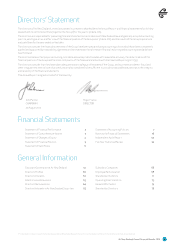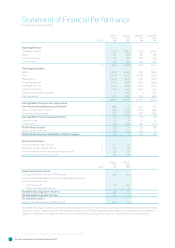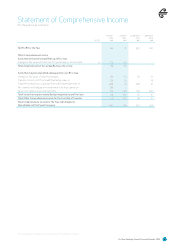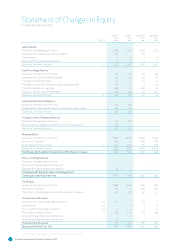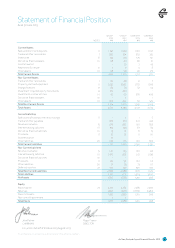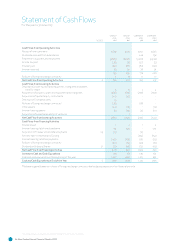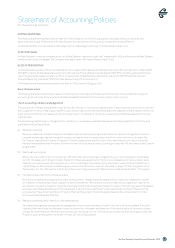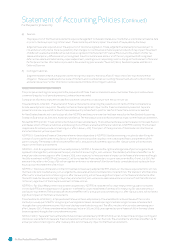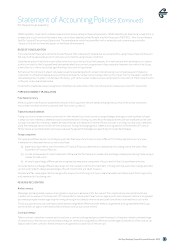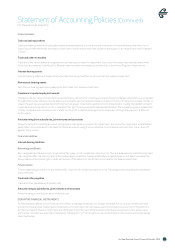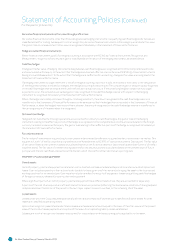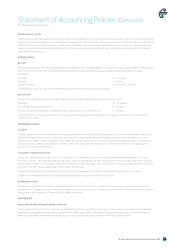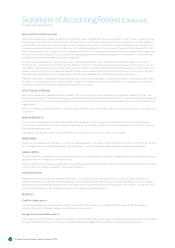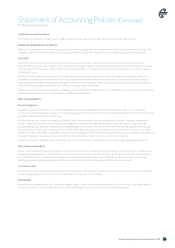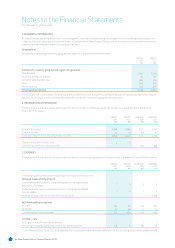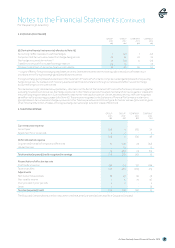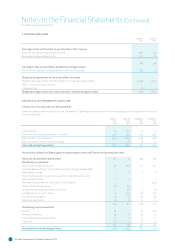Air New Zealand 2013 Annual Report Download - page 10
Download and view the complete annual report
Please find page 10 of the 2013 Air New Zealand annual report below. You can navigate through the pages in the report by either clicking on the pages listed below, or by using the keyword search tool below to find specific information within the annual report.
Air New Zealand Annual Financial Results
8
(e) Taxation
The preparation of the financial statements requires management to make estimates about items that are not known at balance date
or prior to the Group reporting its final result. These items may ultimately impact the amount of tax payable by the Group.
Judgements are also required about the application of income tax legislation. These judgements and assumptions are subject to
risk and uncertainty, hence there is a possibility that changes in circumstances will alter expectations, which may impact the amount
of deferred tax assets and deferred tax liabilities recognised in the Statement of Financial Position and the amount of other tax
losses and temporary differences not yet recognised. In such circumstances, some or all of the carrying amounts of recognised
deferred tax assets and liabilities may require adjustment, resulting in a corresponding credit or charge to the Statement of Financial
Performance. Further information is provided in the accounting policies under “Taxation”, Note 4 Taxation Expense and Note 22
Deferred Taxation.
(f) Contingent liabilities
Judgements and estimates are applied to determining the probability that an outflow of resources will be required to sele an
obligation. These are made based on a review of the facts and circumstances surrounding the event and advice from both internal
and external parties. Further information is disclosed within Note 26 Contingent Liabilities.
SIGNIFICANT ACCOUNTING POLICIES
The principal accounting policies applied in the preparation of these financial statements are set out below. These policies have been
consistently applied to all periods presented, unless otherwise stated.
Comparative information has been reclassified to achieve consistency in disclosure with the current period.
The amendments to NZ IAS 1 - Presentation of Financial Statements concerning the presentation of items of Other Comprehensive
Income was adopted on 1 July 2012. The adoption has not had a significant impact on the financial statements presented. Separate
presentation is now required of items which are subsequently reclassified to profit or loss from those that will not be reclassified.
Air New Zealand has elected to early adopt all other NZ IFRSs and Interpretations that had been issued by the New Zealand Accounting
Standards Board as at 30 June 2013, except as noted below. The early adoption did not have a material impact on the financial statements.
Revised NZ IFRS 9 (2010) - Financial Instruments has not been adopted early. This standard adds requirements related to the classification
and measurement of financial liabilities, and derecognition of financial assets and financial liabilities to NZ IFRS 9 (2009). This Standard
is applicable for annual periods commencing on or aer 1 January 2015. The impact of the application of this standard on the financial
statements has not yet been quantified.
NZ IFRS 10 - Consolidated Financial Statements has not been adopted early. NZ IFRS 10 builds on existing principles by identifying the
concept of control as the determining factor in whether an entity should be included in the consolidated financial statements of the
parent company. The standard, which becomes effective for annual periods commencing on or aer 1 January 2013, will not have any
impact on the financial statements.
NZ IFRS 11 - Joint Arrangements has not been adopted early. NZ IFRS 11 focuses on the rights and obligations of joint arrangements as
opposed to the legal form, and requires the equity method of accounting for joint ventures. The standard, which becomes effective for
annual periods commencing on or aer 1 January 2013, is not expected to have any material impact on the financial statements, although
the 51% investment in ANZGT Field Services LLC will be reclassified from a subsidiary to a joint venture with effect from 1 July 2013. Net
assets aributable to the Group of $1 million together with minority interests of $1 million will be de-consolidated and replaced with an
equity accounted investment of $1 million.
NZ IFRS 12 - Disclosure of Interests in Other Entities has not been early adopted. NZ IFRS 12 sets out disclosure requirements for entities
that have interests in subsidiaries, joint arrangements, associates and unconsolidated structured entities. The standard, which becomes
effective for annual periods commencing on or aer 1 January 2013, will not have a significant impact on the financial statements, other
than additional disclosures relating to the primary statements of joint ventures or associates and a reconciliation from that information
to the carrying amount of the Group’s investment in those entities.
NZ IFRS 13 - Fair Value Measurement has not been adopted early. NZ IFRS 13 replaces the fair value measurement guidance contained
in individual IFRSs with a single source of guidance. It defines fair value, establishes a framework for measuring fair value and sets out
disclosure requirements. The standard, which becomes effective for annual periods commencing on or aer 1 January 2013, will not have a
significant impact on the financial statements.
The amendments to NZ IAS 19 - Employee Benefits have not been adopted early. The amendments removes the use of the corridor
method previously permied for recognising actuarial gains or losses, instead requiring immediate recognition as a remeasurement
through other comprehensive income. Additional disclosures will also be required. The effective date is for periods commencing on or
aer 1 January 2013. If these amendments had been applied as at 30 June 2013, unrecognised actuarial losses of $19 million would have
been recognised through other comprehensive income.
NZ IAS 27 (2011) - Separate Financial Statements has not been adopted early. NZ IAS 27 (2011) carries forward the existing accounting and
disclosure requirements for separate financial statements with some minor clarifications. The amendments, which become effective for
annual periods commencing on or aer 1 January 2013, will not have any impact on the financial statements.
Statement of Accounting Policies (Continued)
For the year to 30 June 2013



